Swap Don't Shop
Topshop, Oxford St, Sat 29 Nov
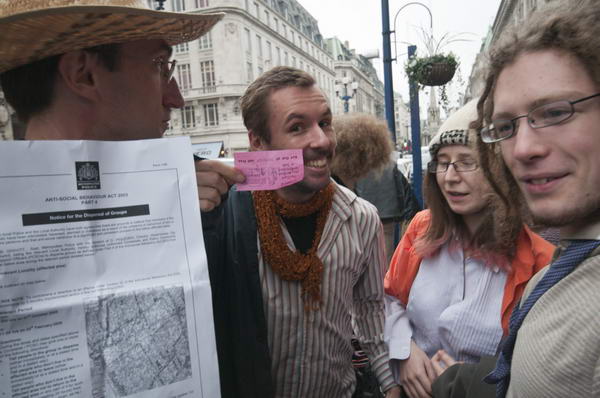
The "Get out of Topshop Jail Free" card came
in handy - but he still got an Anti-Social Behaviour Act order
more pictures
"Take your clothes off! Swap them with your friends for FREE!"
was the message from the Space
Hijackers, who decided to set up their clothes swap - "the restyling
fashion mash-up event of the year" - on the lower ground floor of
TOPSHOP at Oxford Circus. The idea was to demonstrate that "we don't
need to spend money we don't have on things we don't need."
The action, designed as it was to subvert one of the iconic temples of consumerism
seemed to baffle police and didn't amuse the security staff, who stopped me
taking pictures there. One other photographer was manhandled out of the store,
but I was treated very politely, with several security men standing between
me and the action and telling me that photograph was not allowed. On of the
store managers even offered to personally help me find any clothes I might
wish to buy elsewhere in the store, a possibility I found most unlikely.
I left the store (with a rather large escort until I left the premises) and
walked around to the side exit where I expected the clothes swappers to be
ejected, arriving just before they emerged, and was able to photograph them
continuing to swap clothes on the pavement in Regent Street. Here one policeman
did attempt to prevent me from taking pictures, claiming I was causing an
obstruction (which clearly I wasn't) and as usual I moved back a couple of
feet before returning to take pictures when he moved away.
Things did threaten to get out of hand when a rather elderly police officer
(at my age all policemen are supposed to look young), helped by a 'Red Cap'
(rather sinister private security wardens employed by the 'New West End Company'
to ensure shoppers don't step out of line) started to push people around,
but mostly other officers took a more sensible approach, some even talking
and joking with the swappers as they continued to exchange items of clothing
on the pavement.
Some shoppers passing by stopped to watch, and a few took a leaflet, but
there was no evidence of any Damascene conversions, most hurrying on clutching
their loaded shopping bags, desperate to spend more money.
One of those taking part was held by the police for a while as they had decided
he was the ringleader. He got a big cheer when he was released, waving his
pink 'Get out of TOPSHOP Jail Free' Chance Card and the Anti-social
Behaviour Act Notice
for the Dispersal of Groups which the Met had given him. This required
him to leave the Oxford St/Regent St area for the next 24 hours. Fortunately
the map provided didn't include the Red Lion, where he announced his intention
of going - and at this point I also left as I was already late for a meeting
with friends in Streatham. Some of the others looked as if they were going
to continue their fun along Oxford Street.
more pictures
Burma Democratic Concern 24hr Hunger Strike
Parliament Square, London 26-27 Nov 2008
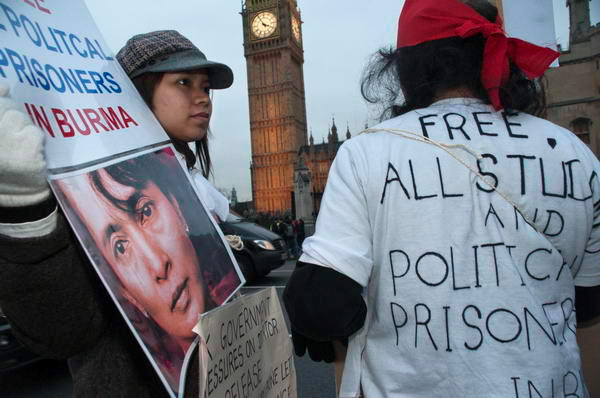
Protesters opposite the Houses of Parliament
more pictures
The Burmese National League for Democracy (NLD), whose general secretary
Aung San Suu Kyi is still under house arrest in Burma, organised a 24hr hunger
strike in solidarity with Burmese political prisoners starting at 9am on Wednesday
26 November in Parliament Square, London.
In particular the demonstration was to show support for Burmese student leaders
imprisoned for 65 years by the Burmese military dictatorship, and to urge
the UK Government and UN Secretary-General Ban Ki-moon to take urgent action.
Those taking part wore white clothing, both because this is the prison uniform
in Burma and also because white represents peace.
While I was taking pictures there was heavy traffic past the demonstrators
and their banners, and a number of motorists sounded their horns to express
support for the cause.
more pictures
Protest as ID cards start
Lunar House, Croydon, London Tuesday 25 Nov, 2008
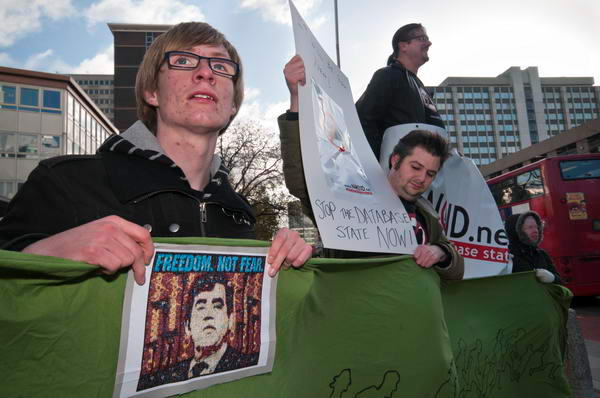
Protesters outside Lunar House on the day the first ID cards are issued
more pictures
On the corner of George Street in Croydon, London, a November sun was warming
the shoppers and office workers on their lunch breaks, but a few hundred metres
north on Wellesley Road a biting Siberian wind seared the demonstrators outside
Lunar House. It seemed appropriate that such a freezing blast should surround
the UK headquarters of the Border and Immigration Agency and indeed
be generated by its twenty stories of the grim early 1970s office complex.
After all its raison d’être is to give would-be immigrants and
asylum seeks an extremely cold reception.
Its bleak anonymity is also a warning of things to come for all of us in
a Brave New Britain of state surveillance and control whose infrastructure
is increasingly with us through security cameras, the interception of mobile
phone signals and electronic communications and the planned introduction of
universal ID cards.
The picket, called by London NoBorders
and NO2ID, marked the start of Biometric
ID cards, which are being issued from today, 25 November 2008, to all
non-EU students and spouses applying for or renewing visas for study or marriage.
The cards will have a photograph with name, date of birth, nationality, immigration
status and biometric details, including fingerprints and digital facial image,
will be stored on a chip on the card as well as being held indefinitely on
the UK Identity Service database. Soon all foreign nationals in the UK will
be required to have these cards, which will be rolled out to other groups
including students who want a student loan by 2010. And from 2011 you will
need to get one – and have your details on that database - if you want
to renew or get a passport.
What worries many of us is not just the use to which our own government and
security services might make of such data – linking to face recognition
software working on images from security cameras and mobile phone data would
enable our every move to be tracked – but the certainty that it will
get into other hands – such as those of our US friends in the CIA, as
well as criminal and commercial organisations who will have their own ideas
about how such all-pervasive data might be used.
Among those at today’s demonstration was David
Mery, one man who has achieved a small personal victory against the juggernaut
database state.
Mery was stopped by police entering Southwark tube station on 28 July for
being "calm on arrival, almost too calm" and having a largish
rucksack and a strong French accent. It was three weeks after the London bombing
– and - perhaps luckily for him, six days after the shooting of Jean
Charles de Menezes. This time at least the police didn’t shoot first
and ask questions later, but his treatment in the months and years following
the event can most favourably be described as Kafkaesque. He finally (or at
least probably) succeeded in having both his fingerprints and DNA record removed
from the police databases, but it took over two years of fighting. His blog
and articles are essential reading for anyone who wonders why civil liberties
are important.
more pictures
Justice 4 Ricky Bishop March
Brixton, London. Nov 22, 2008
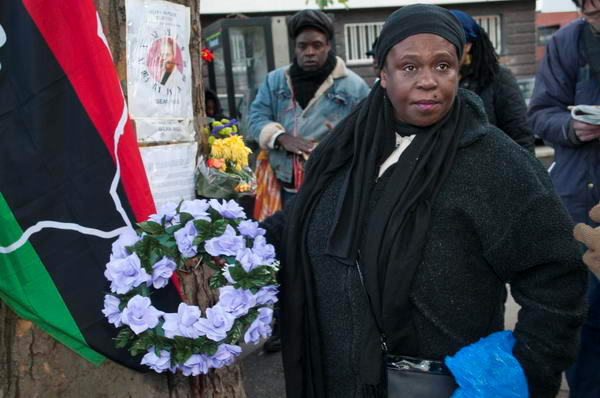
Families of Ricky Bishop, Sean Rigg and Derek Bennett were among those taking
part
more pictures
Ricky Bishop, Sean Rigg, Derek Bennett were the names on the banners
and placards as demonstrators made their way from Brixton to Peckham on Saturday
afternoon. Around 50 people had gathered outside the Tate Library for the
march, organised by London branch of The International People's Democratic
Uhuru Movement (InPDUM), "a grassroots organization, led by
the black working-class community... founded in 1991 in Chicago by the African
People's Socialist Party. "
After a short introduction, the march made its way up the high street to
Brixton Police Station, where Ricky Bishop died after being arrested during
"Operation Clean Sweep" - which they describe as a "modern
day lynching" - on November 22, 2001. Others joined them there for
a short rally around what they have named the "lynching tree"
in front of the station where a number of arrested black men have died in
highly suspicious circumstances.
Among those taking part were members of Bishop’s family, and those
of Derek Bennett, shot in the back by armed police while holding a gun-shaped
cigarette lighter in 2001, and Sean Rigg, who died after being taken ill in
police custody in Brixton Police Station on Thursday 21 August 2008. There
was a minute's silence in memory of the victims and family members added a
wreath and other flowers to those already present on the lynching tree.
Speakers called for a boycott of the official enquiries that are designed
to hide the truth and whitewash the police. Justice would only be delivered
by the prosecution of all officers responsible for these and similar deaths,
including ten officers who were named for their part in the murder of Ricky
Bishop.
Speakers and the slogans chanted on the march called for an end to all official
violence against the black community, and for economic development, with resources
for black businesses rather than increased spending on police repression.
They called for the community to get organised through groups such as the
InPDUM as the only way to defend themselves.
More than 60% of black families live on less than half the national average
income and they suffer from under-funded schools and welfare services, poor
food and high levels of drugs, gun and knife crime. Marchers accuse the police
and government of bringing drugs, guns and knives into the country and of
carrying out a public policy of brutality to contain the African community
through policies such as Operation Clean Sweep. Black men are harassed
on the street, being stopped and searched 8 times more than the average, and
a high percentage have had DNA samples taken against their will.
I left the march on its way to further rallies at Camberwell Green and Peckham
Square. You can also see pictures here on My
London Diary from the recent annual Whitehall march by the ‘United
Friends and Families’ of those who have died in police custody.
more pictures
PARIS SUPPLEMENT
Millie and Jim's Paris Photo Party
Bastille, Paris. Thursday Nov 13, 2008
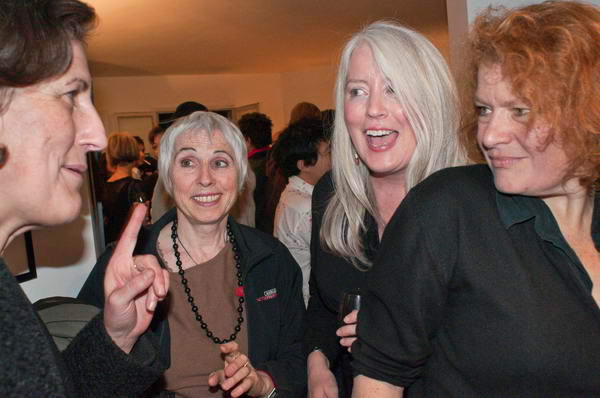
It's always a delight to meet Millie and Jim Casper, and
lensculture is one of the best web
sites dealing with photography in an intelligent way - and showing a great
deal of fine work in the online magazine and blog. So it's hardly surprising
that their party during Paris Photo attracts a great crowd of very talented
people including photographers, film-makers, publishers, gallery owners and
others with an interest in the medium. I've decided not to caption these images
and I'm not going to name-drop, but if you are up with the photographic scene
there may be a few you recognise. On the linked pages they are presented in
the order that I took them.
As well as the people, it helps that the champagne sparkles equally and there
are plenty of fine things to nibble; if you need some air (or to smoke) the
balcony has a fine view along the rue Saint Antoine. It really was hard to
tear myself away to get the Metro back to my hotel around midnight; last year
I hear the party was still going until an early breakfast.
As always I took many more pictures than appear here, and if anyone who was
at the party and can't find themselves in a picture I'll happily look and
see if I have one of you should you ask. And as usual I'll be happy to supply
larger files if anyone in any of the pictures would like to print themselves
a copy.
more pictures
Buttes Chaumont and Ronis's Belleville Traversée
Paris, Monday 17 Nov, 2008
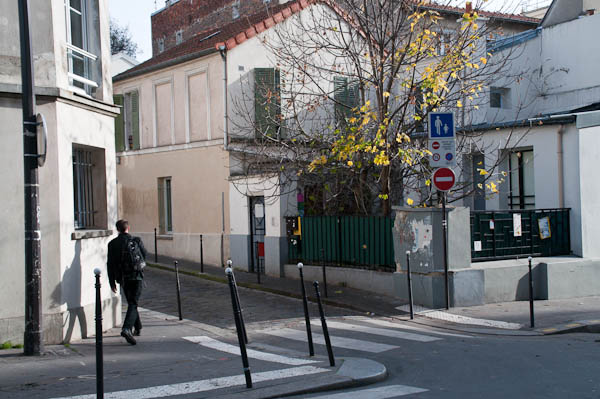
We followed in the steps of Willy Ronis, recorded
for his show at the Bar Floréal in 1999
more pictures
Monday we booked out of our hotel around 10h, leaving our luggage in the
foyer to collect later and walked slowly to the 19e, exploring a few things
on the way. Our first goal was Paris's most fantastic park, Buttes Chaumont,
a former gypsum quarry and waste tip converted into gothic fantasy, and as
we reached the temple on the top of its great mound above the lake we looked
down and saw around a thousand school children taking part or cheering on
the runners in a race around the lake.
From there we made our way south to Belleville and began to follow the route
from Willy Ronis's la traversée de Belleville, which I had
been given a few days earlier in the bar Floreal. Linda was keen to identify
the exact locations of his pictures, and we managed a few, but some areas
had been very extensively redeveloped so that no traces remained - even some
of the streets were no longer quite in the same place. I was more interested
in taking my own pictures.
Half way round his circuit we felt hungry, and on the rue des Pyrenees was
a restaurant ‘Aux Monts D’Auvergne’ and we went
in. It was good to end our stay in Paris with the best meal we ate there.
I started with an exquisite egg and blue cheese dish, moved on to tasty and
filling roast beef on a potato mountain, and was finished by a truly delicious
chocolate surprise, a gateau to die for. Washed down by a decent cheap house
red, it was a meal that money wouldn't buy in England, and even with the sinking
pound at the sort of price you might well pay for chips with everything at
a motorway service station.
After the meal, we managed to finish our circuit of Belleville and then walked
back to our hotel to collect our luggage and wheeled it to the Gare du Nord
in plenty of time to check in early for our Eurostar, which left to the second
at 17.13 and despite the fire in the tunnel earlier in the year which has
resulted in a slightly slower service, we pulled into St Pancras at 7pm and
a bus and a train later werel home on the outskirts of London by 8pm. I can’t
understand why some people still fly to Paris.
more pictures
Sunday: Marais, MEP, Seine...
Paris 16 Nov, 2008
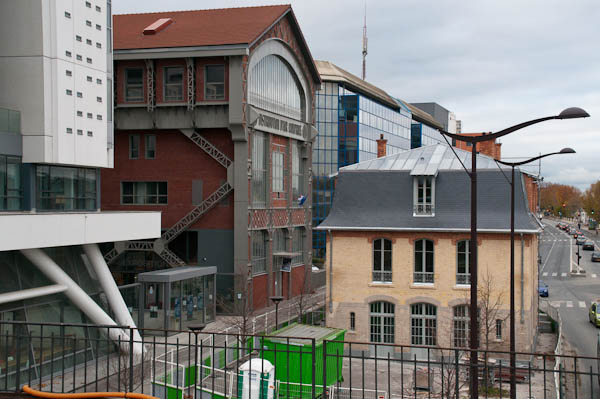 Société Urbaine d’Air Comprimé (SUDAC) building
Société Urbaine d’Air Comprimé (SUDAC) building
more pictures
Sunday we again left the hotel soon after breakfast, with Linda setting out
to walk to attend morning service at the Protestant temple. I deviated half
way and struck out towards my own chosen place of worship, the Maison
Européene de la Photographie (MEP), but as this didn't open until
11h I had plenty of time for a wander around parts of the 3e and 4e.
I've written previously about the several shows I saw at the MEP,
including a retrospective of Sabine Weiss, who was at the show signing
books and talking to people. I knew a few of her pictures, but as so often
the show revealed far more with some very moody images of Paris in the early
1950s. But her outstanding pictures were those of children taken in various
cities and at various times, showing her ability to enter and share their
world.
A few years ago I wrote a feature about Göksin Sipahioglu the
Turkish photojournalist who made Paris his home and started his famous news
agency 'SIPA', there. In many ways he could have been the man for
whom ‘f8 and be there’ was coined, but the pictures in
the smaller show about him sometimes showed rather more. I’m sorry that
my earlier feature is no longer on line, but perhaps I might make a few revisions
if I were to write again.
It took me roughly two and a half hours to make my way around the various
shows in the MEP (though I didn’t stop long at the videos in the basement)
and I walked out just as Linda arrived bearing supplies for lunch, some delicious
flans which we sat and ate in a small garden not far away, entertained by
a nearby (but not too near) Jewish jazz band, while we planned our afternoon.
Linda was heading for the new(ish) Bibliotheque nationale to see an exhibition
of children's books, while I was intent on finding two Mois de la Photo shows,
Recollections, by Philip Jones Griffiths, who dies earlier this year, and
the other e by Patrick Tournebeouf. Despite confusingly being listed in the
leaflet under different arrondissements both were in the same building at
the same address (in the 13e.)
We decided the weather was good enough to walk east along by the Seine -
much more pleasant on a Sunday as the riverside motorway is closed to traffic
and taken over by cyclists, joggers, roller-bladers and walkers. Linda left
me to cross the river at the recent complicated foot and cycle bridge dedicated
to Simone de Beauvoir which took her onto the decking of the BN, while I continued
further along the river hoping to find another bridge to cross.
While London's river is largely abandoned to a frontage of expensive flats,
the Seine has kept much of its industry, even quite close to the centre of
the city, and I was enjoying a walk past yards full of building supplies,
sand and gravel.
Soon I was regretting having let Linda take our only map, as the path led
under a couple of bridges - one carrying the Périphérique -
with no access to them, and there was no other crossing in site. Eventually
I crossed over several rather busy slip roads and climbed up some steps onto
what turned out to be the Pont National, and crossed this, finding that the
fine industrial building built in 1891 (Engineer: Joseph Leclaire, Architect:
Lebris, now protected as a historic monument) for the Société
Urbaine d’Air Comprimé (SUDAC) with the message in large
text on its frontage: 'Distribution d'air Comprime', was now the
very gallery for which I was looking. You can read about this show, and that
by Patrick Tournebeouf here on >Re:PHOTO
These two shows kept me longer than I expected, and I had to rush back to
the BN where I'd arranged to meet Linda, stopping a few times to again photograph
a riverine industrial landscape. But I wasn't sorry to have to hurry, earier
in the day it had been pleasant with the occasional bit of sun, but now there
was the occasional shower swept across by a cold wind.
Linda had found the children's book exhibition very disappointing - certainly
not up to the standards of the British Library (her employer a long time since.)
Together we made our way again to Les Frigos, this time to see the show in
Les Voutes by Magnum photographer Patrick Zachmann. I think
his 'Un jour, la nuit' very much reflected the experiences of a photographer,
a stranger in the various cities he visits, with nothing to do and nowhere
to go in the early hours of the morning. It's a time when one would be better
off in bed rather than on the streets, and to my eye the pictures reflected
both the boredom and the tawdriness of his experiences.
Frankly there were a lot of things I felt no need to see, and from which
I gained very little in viewing. Zachmann, as can be seen from his Magnum
portfolio, is a far better photographer than this show suggests, and I
look forward to his May 2009 show at the Cité d'Histoire de l'Immigration
in Paris (Centre for the History of Immigration)which will present his photographs
from twenty five years, work on immigration and the suburbs.
It was time to give up and go back to our hotel, and then out again for a
truly French meal at a restaurant just off the rue Moufettard. We ate early
and it was almost empty, and were treated to a more expensive menu than we
had ordered, and the food and drink was fine.We walked down from there to
the Île de la Cité - the rain had more or less stopped - before
catching the Metro back to our hotel.
Pictures from the day
Saturday in Paris - Art & Tourism
Paris, 15 Nov 2008
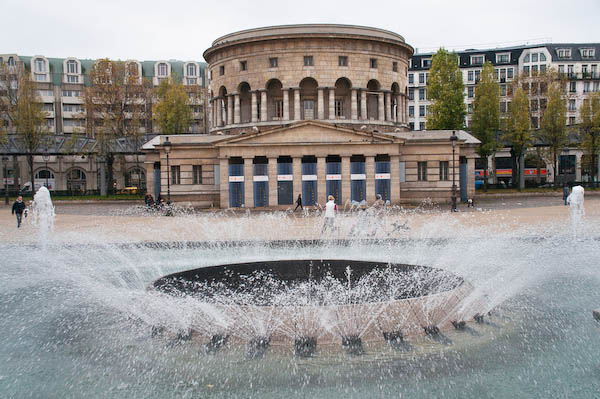
Rotonde de la Villette, 19e
more pictures
On Saturday one of the shows in the Mois de la Photo claimed to be open from
10.00am and it looked interesting. Even more of an attraction was the fact
that we could make another pleasant early morning walk along by the canal
north from the Place Stalingrad to get to the Ecole nat. sup. d'architecture
de Paris la Villette on the avenue de Flandres. When we arrived, the
buildings were pretty well deserted, but there was a guard sitting in his
box at the entry. When we asked he didn't know if the show was open, but he
made a phone call and we were soon allowed through.
Domiciles by Gilles Raynaldy, as you can read on >Re:PHOTO,
turned out to be one of the more pleasant and rewarding shows of the Mois.
From the avenue de Flandres we walked half a mile or so west to the newly
opened Arts centre, Le 104 (Centquatre) in the former home
of the municipal funeral services. More about that and the two photographers
whose work we saw there also on >Re:PHOTO.
We took the Metro to the centre of Paris, and for a short non-photographic
interlude, including a nostalgic picnic in the Square du Vert Galant on the
tip of the Ile de la Cite, before taking another short Metro trip to Galerie
Vu near the river in the 4e, where we viewed the show Vinter
by Swedish photographer Lars Tunbjork, who I had
met and shown with in Poland (see >Re:PHOTO.)
There were still plenty of shows in the Marais that I wanted to see, and
so we began a traverse. We made a brief call into Galerie Maia Lund where
Peter Martensen's Testing Freedom, a couple of video pieces.
were on show, but as so often with video I found it too tedious to watch for
long.
Fortunately not far away in the rue Ste Anatase there were a couple of shows.
Actually in the Galerie sit down was a Photo Mois show 'Grece:
les annees d'innocence' by Robert McCabe, while neighbouring
shop windows were full of 'Les Poupees Bidons' by Aurelia Alcais,
a part of the Photo-Off. (see >Re:PHOTO)
From bellies it was on to the rue Debelleyme and an impressive mansion turned
into a large gallery space, the Galerie
Karsten Greve, which had a large show of the work of the Italian photographer
Mimmo Jodice (b Naples, 1934).
His 'Les Parcours de la memoire' (Paths of Memory) was an large
and somewhat varied show, full of the kind of landscape and statures I associate
with him, and which frankly I soon find rather boring. I think his early work
on Naples if probably far more to my taste.
Across the road was the Galerie
Blue Square where I was able to see the remarkable images from the Global
Underground project by artists Valera and Natasha Cherkashin.
(see >Re:PHOTO)
We made short visits to several other shows in the area around the rue Vielle
du Temple, but most didn't detain us long. There seemed to be a number aimed
at a fetish market, not a scene that arouses anything much in me.
A notable exception came in the rue du Perche, with John Bulmer's 'Hard
Sixties: L'Angleterre post-industrielle, black and white and colour images
from the 1960s takenin the north of Englinad, particularly around Manchester.
(see >Re:PHOTO
)
By now it was getting dark and the troops were revolting if not actually
mutineering and it was time to return to the hotel and get ready for dinner.
We were meeting our Paris relations on the Grands Boulevards, but when we
found them (only 5 minutes late) they were both suffereing from bad colds
and feeling sorry for themselves. We weren't too hungry either, suffering
from the cumulative effects of a week of eating out, so rather than the three
courser at Chartier we'd been comntemplating we settled for a creperie instead.
Although not unpleasant, it was the least memorable meal of our stay and thugh
relatively cheap seemed poor value.
We said an early goodye and they entrained back to the suburbs and an early
night, but we were ready for more and decided on the tourist thing, taking
the metro to Trocadero again and walking down and across the bridge to stand
under the Eiffel Tower, admiring its ring of blue starts to mark Szarkozy's
stint for Europe.
Away from the tower and its tourists the neighbouring streets were dead and
deserted, with no signs of any night life. We walked for half a mile or so
through empty streets before we came to a bus route, where we waited a quarter
of an hour for a bus that took us to the Place de Clichy, vaguely in the direction
of our hotel.
Here the boulevard at least was still lit up and there were plenty of people
as we walked on past Place Blanche and on to Place Pigalle, wandering past
or hanging around the various sad-looking neon-covered come-on facades of
sex shops and clubs. So of course I took some more pictures, though with the
large and obvious Nikon I kept my distance and concetnrated on the signs.
One that particularly amused us was on the Moulin Rouge itself, glowing green
for les Doriss Girls - the only Dorises we know are elderly stalwarts of the
local Methodist church choir.
more pictures
Friday in Paris - More Shows
Paris, 14 Nov, 2008
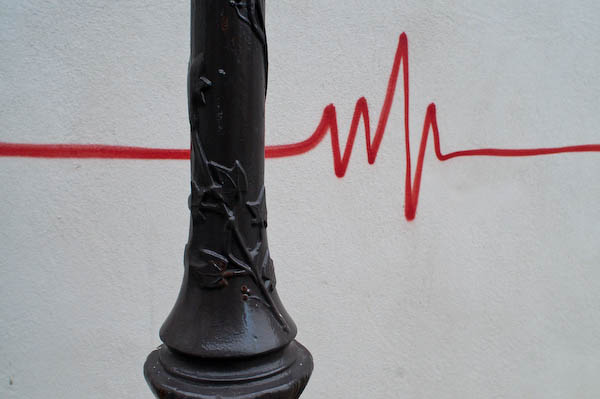 La
cour de la Ferme Ste Lazare, 10e
La
cour de la Ferme Ste Lazare, 10e
more pictures
Friday we finally got in to the Photo-Off show at the Carre Saint Lazare,
sensitive portraits by Sylvie Valem of people with what in the UK
are I think officially called "learning disabilites" (in
French, handicapée). The black and white portraits were accompanied
by signatures made by the people in the picture and a colour picture related
to their favourite object or interest and a short text. Although the pictures
were sensitively taken and showed something of the complex personalities of
people who once would have been called 'simple', I felt the printing sometimes
let the pictures down. It was however interesting to see the building from
the inside, looking out over an interior garden in which considerable building
work was taking place.
We took a slight detour on our route to the metro to take in Passage
Brady, an on our way by chance came across a small display of pictures,
'Carnets de passage' about it by Lika Banshoya (we'd earlier
looked for the address given in the brochure, but it seemed to be somewhere
different.) I'm afraid I found the actual passage, not a great distance away,
considerably more fascinating. I first ate an Indian meal there many years
ago, and it still seems like finding oneself somewhere in the sub-continent,
although in November it was considerably cooler.
We were on our way to the metro, which we caught to St-Germain-des-Pres,
another Photo-Off venue, with pictures in permanent cases built for art display
along the platform. One of those showing, Thomas Lang, was featured
in the program for his images of the city seen out of focus through foliage,
which I'm afraid failed to engage me.
We aren't sure whether or not we found all of the work by John Baptiste Blom
at the Librarie La Hune, close to the station, but I'm sorry to say I wasn't
motivated to look for more, and we strode off in search of the next show.
In rue Mazarine we came to 'L'Archipel', a show of black and white
and colour work by Patrick Mourral (b1976), one of many shows in
Paris that wasn't a part of any festival. It closed on 29 November, but I'm
sure will be seen again elsewhere. You can read my views on it at >Re:PHOTO
A couple of hundred yards down the road, lined with galleries and antique
shops, we came to the North Circular Road.
Not of course the actual North Circular, which runs from Kew Bridge to the
Woolwich Ferry through suburban London, but a Mois de la Photo show by Beniot
Grimbert at l'Ecole Nationale Supérieure d'Architecture Paris-Malaquais.
You can see a slightly extended version of the 20 pictures on show there on
his web site.
And again you can read my views on his show on >Re:Photo
Our next call was at the Palace de Chaillot for the show Moscou Verticale
by Gabriele Basilico, once more my views are on
>Re:PHOTO
By the time we emerged, it was getting late for lunch and we were feeling
hungry. A short walk around the area convinced us that this was a place for
the rich to eat, and we jumped on a train to Abbesses where we had
a sizeable snack at a whole-food shop, before jumping back on the metro to
make our way to the show at the Bar
Floréal.
We had to hurry away from the Bar Floréal because there were several
other things I wanted to see. Our next call was not far away at the Cité
des trois fushias, blocks of modern ten-storey flats around a large courtyard.
The first problem was getting in through the security gate to the courtyard,
solved in the normal way of waiting until someone came out. We then wandered
around vaguely hoping to see some notice telling us about this Photo-Off event,
but these were top small and insignificant for us to find (if they were visible
at all.) Finally one of the group concerned, Colectif Tribuydom, who were
setting up a film for later, saw us wandering and took pity on us, letting
us in to the secret and, when he had found the security code, into the block
on the east side of the court. I've written more about this show again on
>Re:PHOTO, but you can also
see more of the pictures from the show on this site.
Finally we went to see another couple of shows that were also taking place
in Paris outside the Mois and the Photo-Off, that I had particularly wanted
to go and see. Both are covered on >Re:PHOTO and they are by Gilles
Perrin and Catherine Cameron.
More pictures from the day.
The Canal, Les Halles and more
Paris 13 Nov, 2008
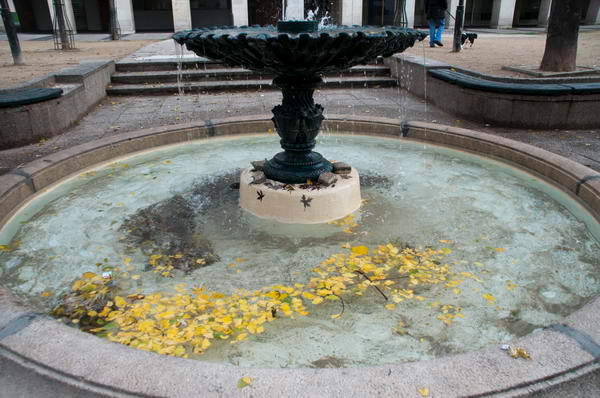
Autumn in Place Raoul Follereau, 10e and a fairly early morning walk for the
dog
more pictures
Before Paris Photo opened at 11.00am we had time for a walk around
one of our favourite parts of Paris, (checking our nearest show again - still
exceptionally closed) along the Canal Saint Martin in the 10e, just
walking until around 10.45 when I jumped on the nearest Metro to take me to
the show.
After putting in another two and a half hours there I met Linda in the gardens
of the Palais Royal and we found a cafe for a late lunch (not bad
at all) before taking a nostalgic walk through Galerie Vero Dodat
to the rue Jean Jacques Rousseau. We stayed in a student hostel here
on our first trip to Paris after we were married (it wasn't quite our first
visit, we spent a week a before we were married at another student hostel
a few miles south of the city in Massy-Verrières - nor our honeymoon,
which was spent in Manchester - with a day trip to the Lake District.) Then
it was on the edge of les Halles, but now about all that now remains
of that is St Eustache (our walks are church crawls as well as photo crawls.)
A short distance to the east (after a detour into Saint-Leu-Saint-Gilles)
was Rue Quincampoix, where what were then brothels are now art galleries,
and we found a couple of photo shows to view, and there were more along rue
St Martin and an opening on rue Payenne.The we had to rush off to get to another
opening in the 13e before I went off to the lensculture party and
Linda to a lecture at the Temple protestant de l'Oratoire du Louvre.
I'll write more about the shows shortly on >Re:PHOTO,
and you can read and see pictures from the party, but
I'll spare you the details of the lecture.
more pictures
More Shows, more walking
Paris, 12 Nov 2008
 A
nicely decorated facade
A
nicely decorated facade
more pictures
We went out for a walk after breakfast, too early for photo shows (and that
one that claimed to open at 9.30am was again "exceptionally closed.")
But by mid-day more were opening, and our first stop was the Galerie
Fils du Calvaire in the 3e, which was showing Périphéries
by Mohamed Bourouissa. These were staged images from the estates around the
edge of Paris, "la banlieue", usually translated quite misleadingly
as "the suburbs", which evokes Acacia Avenue and rows of
neat semis and bungalows rather than the concrete wilderness of these images,
seen often at night. You can read more about them - and there is a link to
another gallery with 15 reasonably sized images - on >Re:PHOTO.
Getting into the Galerie Fils du Calvaire was a piece of cake, the
porte-cochère was not even locked, and a press of the button and a
muttered request got us through the next glass door and in. Galerie Berrger,
just down the road, was just a little trickier, as the outside gate was locked,
but fortunately someone came out just as we approached. It took several tries
to translate the rather long number we then got from the entry phone correctly
to the key pad, and we tried both in English and French before finally realising
what was meant.
Berrger make a 100% cotton paper designed
for hand coated alternative process work, and the show there was by two photographers
who had made kallitypesusing this. You can read about it on >Re:PHOTO
Our well-thumbed 'Paris Practique' eventualy got us to the Cité
Dupetit Thouars and Galerie Wanted Paris down at its very end. I
found it very disappointing to see work displayed without even photographer's
names in what was a large and very mixed show.
But at least once found the gallery was easy to get in to, and later in rue
Chapon at Galerie Eric Dupont we had the shock of an actually open
door onto the street when we called to see work by Anne-Marie
Filaire. We had expected to see large black and white images Slovenia,
Croatia and Italie, but those on show were from Phnom Penh, although I'm not
sure it made much difference.
Le Petit Endroit in rue Portefoin was showing work by Enrico
Dagnino, but although we could see it through the window and there was
a jacket on the chair, we had obviously come at a time when the invigilator
was otherwise engaged and there was no way to get in.
Galerie Michèle Chomette did have a small notice on the street,
but from then on you were on your own. We would have given up, but a more
persistent Frenchman appeared to press every button on the entry phone and
had a long conversation with the only person who would answer, a young woman
who lived on the first floor and had never heard of the gallery. Eventually
she was persuaded to let us in to the building and we walked up the two floors
to the gallery, which was showing the cold winter landscapes, Paysages
exfiltrés, of Guillaume Lemarchal. Again, more on
>re:PHOTO shortly
Finally I reached Paris Photo in the bowels of the earth below the
Louvre, and was able to begin my first session there - and I'll write more
about that on >Re:PHOTO also. You can find a shortish overall view of what
was expected to be there on the Photography
Collection blog, though I'll only write about a few aspects that caught
my attention.
more pictures
Night in the City Centre
Paris. 11 Nov 2008

It poured with rain and I got wet, so I didn't take too many pictures
more pictures
Cimetière du Père-Lachaise
Père Lachaise is the largest cemetery within the city of Paris, and
contains the graves of more famous people than you can think of, although
many of the finer monuments are to those I've never heard of. This time we
just did a brief and fairly random walk from the Gambetta entrance to the
main gate. It's perhaps the best way to see the cemetery as you are walkiing
down hill.
more pictures
Cérémonies du 11 novembre
Mairie du 20e, Place Gambetta, Paris. Nov 11, 2008
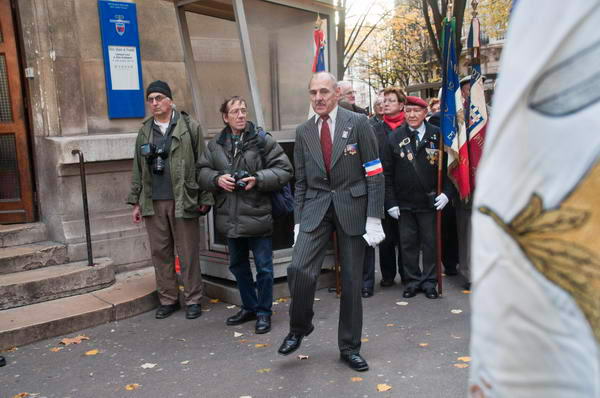
Two rather bored photographers watched the event
more pictures
We were sitting in the cafe opposite the town hall in Place Gambetta and
I was enjoying a Blonde (the only beer on their list I hadn't tried before)
while Linda tried to warm herself up with a hot drink.
Suddenly we heard the sound of a brass band, and then saw out of the window
an approaching procession, and I picked up my camera and rushed out, leaving
Linda to guard my camera bag and half-finished beer.
Coming across the place and going down the street towards the back of the
town hall was a military band leading various dignitaries with red white and
blue sashes, a couple of banners, a group of children and a small crowd of
adults. It was the union française des associations de combattants,
the comité d’entente des associations d’anciens combattants
et victimes de guerre along with other associations of patriotic citizens
commemorating the 90th anniversary of the official ceasefire (at the eleventh
hour of the eleventh day of the eleventh month) in 1918, although they were
doing it a few hours later in the day.
The parade (which I later found had started at the Père-Lachaise cemetery
just down the road) came to a halt at the back of the town hall where there
was a memorial to a Brigadier killed in the liberation of Paris in August
1944. Although the November commemoration in France is for the First World
War, there were also groups at the parade remembering the French Jews who
were deported and mainly died in labour and concentration camps in the Second
World War.
I shouldn't have left my bag, as I very quickly realised the card in the
camera was full, and I had to start going through pictures to find ones I
could delete to take these pictures.
more pictures
Le Paris Nord
9e, 10e, and 19e, Paris. 11 Nov, 2008
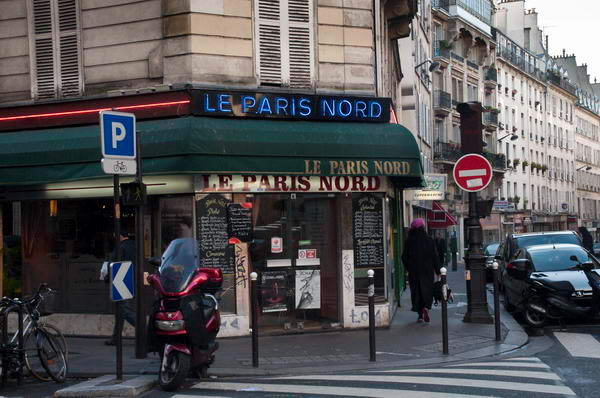
A restuarant not far from our hotel
more pictures
Starting in the 9e and 10e (our hotel was on the border of both) we roughly
folloed a walk from the voluminous but rather badly organised work on the
architecture of Paris before taking the metro to the 19e. I sat in the Parc
de Belleville and ate a very filling takeaway from a Turkish kebab house and
then we walked down to the 20e by a very indirect route along some of my favourite
streets in Belleville and Ménilmontant. I had been hoping to see some
photographic shows, but although many shops were open, they were all closed
for the bank holiday. A pity this wasn't thought worth mentioning in the Mois
del la Photo or Photo-Off listings.
more pictures
Tourist Montmartre at Night
Montmartre, Paris. Nov 10th, 2008
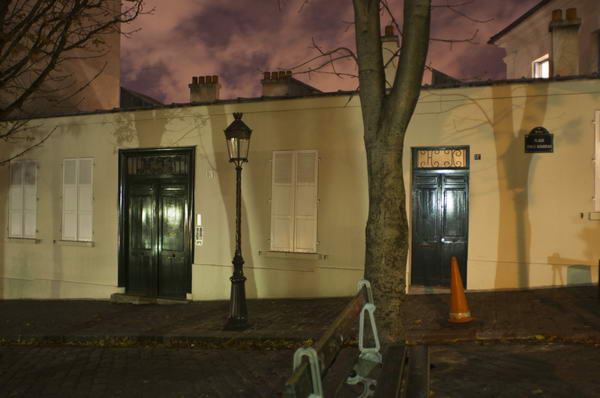
Place Emile Godeau, where Le Bateau-Lavoir was until
the wooden artists studios burnt down around 1970
more pictures
After booking in at our cheap hotel and leaving our bags, we rushed out to
see a few photo shows - which you can read about on >Re:PHOTO
and then decided to have a real tourist evening. So we started with a meal
at Chartier in the
rue du Fauborg Montmartre, just north of Grands Boulevards metro, and a historic
monument. You don't really go there for the food - old-fashioned french grub
at a reasonable price, but for the atmosphere.
Then we took the metro to Abbesses and then caught the funicular up the slope
and took a walk around the inside of Sacre-Coeur just before it shut
up for the night (we had to exit by a side gate.) Montmartre is actually much
better in winter, without the great crush of tourists and it's good to be
able to actually walk across an empty Place du Tertre. We walked around a
bit and I took a few hand-held pictures.
Then we took the bus down to Place Pigalle. It follows a rather convoluted
route giving you a tour of Montmartre, though it would have been quicker to
walk down! But we were out to get the most out of our Carte Orange (to be
replaced by the Navigo Découverte by the end of the year.) Another
short metro ride took us back to Barbès and our hotel.
more pictures
Poles Celebrate Independence Day in London
Westminster, London. Saturday 8 Nov, 2008
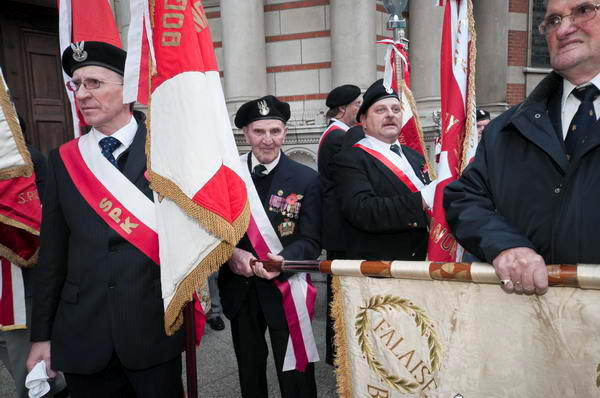
Polish forces fought on the Allied side against Germany in the war
more pictures
The modern state dates from the end of the First World War in 1918 when
the Second Polish Republic was founded - and November 11 is celebrated in
Poland as Independence Day. Although Poland had existed since the 10th century
it disappeared as a state around 1795, being absorbed into Russia, Austria
and Prussia, and only re-emerged with the defeat of Germany.
Unfortunately, independence did not last long, as the German army invaded
in September 1939, starting World War II, followed soon after by Russia occupying
the eastern part of the country. After the end of the war Poland became a
part of the Soviet empire.
Despite a number of popular rebellions, and a growing movement around the
Polish Pope's visit to Poland in 1979 and Lech Walesa and Solidarity from
1980 on, it was only in 1989 that democracy finally returned in Poland.
This year is the 90th anniversary of the foundation of the modern Polish
state, and celebrations took place in London a few days early on Saturday
(8 Nov) in a mass that packed out Westminster Cathedral, after which several
thousands marched to a rally in Trafalgar Square, attended by many Polish
dignitaries, including the ambassador to London, the Polish Cardinal Jozef
Glemp and other leading clerics and Ryszard Kaczorowski, the last émigré
President of the Republic of Poland who handed over the insignia of state
to President of the Third Polish Republic Lech Walesa in 1990.
more pictures
Orange Lodge Remembrance Parade
Whitehall, Westminster, London. Saturday Nov 8, 2008
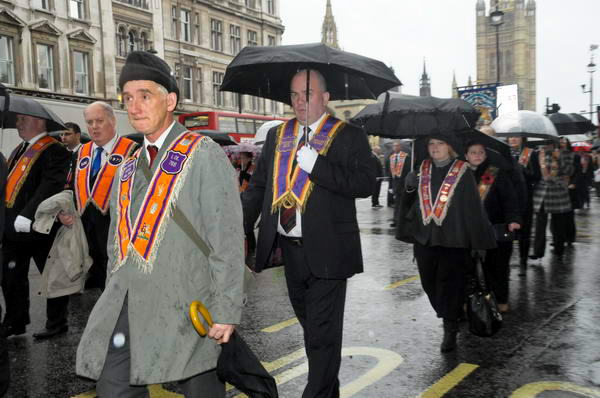
Many marched with umbrellas as the rain poured down
more pictures
Several hundred members of Orange Lodges caught me on the hop as their parade,
organised by the Metropolitan Provincial Grand Lodge of The Loyal Orange Institution
of England started early, doubtless because of the rain which was pouring
down. They marched through Parliament Square and up Whitehall led by drummers
and flutes to the Cenotaph where there was a brief halt to lay wreaths. Another
wreath was placed at the foot ot the grand old Duke of York in Waterloo Place,
where I decided my camera had taken in rather too much water and left the
march.
In Northern Ireland, marches such as these with their loud and penetrating
music sometimes provoke violent feelings (and are perhaps intended to), but
in London they simply add a little colour, welcome on a dull and drab day
such as this. As of course do other Irish events such as the annual St Patrick's
Day parade.
more pictures
War Widows Lay Wreaths at Cenotaph
Whitehall, London. Sat 8 November, 2008
 A
wreath of white crysanthamums and poppiesis laid by a representative of the
War Widows.
A
wreath of white crysanthamums and poppiesis laid by a representative of the
War Widows.
more pictures
Members of the War Widows Association of Great Britain range in
age from their twenties to over 4 times that, women whose husbands were killed
fighting for their country in wars from the Second World War (and possibly
before) through to Iraq and Afghanistan. Men who receive a war widows pension
can also become full members. The group was formed in 1971 by a small number
of widows from the Second World War to fight the unjust tax position of war
widows and now helps widows to deal with the many problems they face.
The wreath contains white chrysantemums as these are a common flower in November,
rosemary as a herb that signifies remembrance and of course poppies that were
adopted because they grew on the fields of Flanders where the First World
War was bloodily waged.
The service at the Cenotaph was a dignified event, although the music of
the RAF band was rather more to my taste than the bagpipers that also accompanied
the short parade from King Charles St.
more pictures
Bee-keepers Protest - Spend More on Research
Westminster, London. Tuesday 5 Nov, 2008
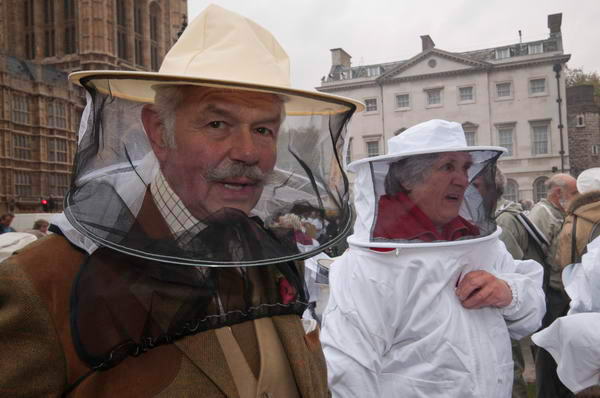 Bee-keepers protest in Old Palace Yard
Bee-keepers protest in Old Palace Yard
more pictures
Forget the birds, it was the bees that led to my existence. My father, then
a young batchelor, signed up for a bee-keeping course at the newly founded
Twickenham and Thames Valley Bee-Keepers Association and made friends with
the similarly aged instructor. Both had younger sisters, and soon, thanks
undoubtedly to the magical properties of honey, there were two engaged pairs
- and, in the fullness of time, me. Both Dad and Uncle Alf kept bees for
money as well as honey, both gained certificates at the shows. Dad's second
war service involved getting on his bike to inspect hives across Middlesex
for foul brood, and for a time he looked after the T&TVBKA's own bees
at the apiary in Twickenham, as well as those of Mr Miller at Angelfield
in Hounlsow, and of course his own on several sites, while Uncle Alf had
hives in west country orchards as well as locally.
So although I've never kept bees, I certainly learnt about them helping
Dad as a young boy, and learnt to love honey. But bees aren't just about
honey, they are vital for pollination of crops, with around a thrid of
what we eat depending on their work. The economic benefit from this in
the UK is about ten times that from honey production at around £120-200
million a year.
But bees are under threat. Since the early 1990s, the Varroa mite has
devasted many wild bee colonies. Bee-keepers have managed to control the
mite, but now strains have developed which resist the treatments. A fungus,
Nosema ceranae has added to the problems.
An even greater threat is colony collapse, a poorly understood disorder
probably cuased by a combination of factors including viruses, stress,
pesticides, bad weather and various diseases. There have been huge loses
of bees in the USA and parts of Europe but as yet is has not reached here.
Around 300 bee-keepers, organised by the British bee-Keepers Association
(BBKA) came to lobby parliament for greater research to combat the threats
to bees and to deliver a petition with with over 140,000 signatures for
increased funding for research into bee health to Downing St.
Most wore bee-keeping suits and hats with veils and some brought the
bee-smokers that are used to calm the hives. Labour MP for Norwich North
, Dr Ian Gibson, spoke briefly at the start of the protest. One
of the few MPs with a scientific background, he was Dean of Biology at
the University of East Anglia before being elected as an MP in 1997. The
current president of the BBKA, Tim Lovett, who led the protesters, was
a former student of his.
more pictures
Leake St Grafitti
Leake St, Waterloo, London. Nov 5, 2008
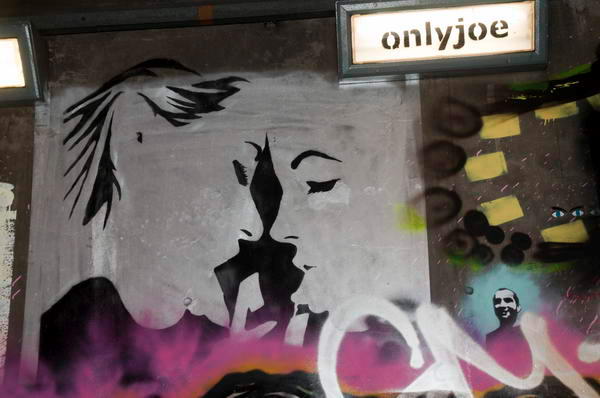
onlyjoe and a little gestalt
I couldn't be bothered to queue for Banksy and friend's Cans
Festival in Leake St in May, but today the tunnel was almost empty
and more or less on my way and I had a few minutes to spare before catching
a train... So I took a few pictures of the display that seems to be changing
pretty regularly along there.
more pictures
top of page
All pictures on this section of the site are ©
Peter Marshall 2008; to buy prints or for permission to reproduce pictures
or to comment on this site, or for any other questions, contact
me.














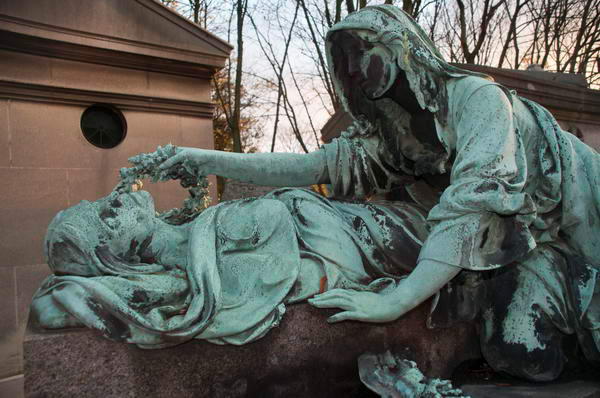






 Bee-keepers protest in Old Palace Yard
Bee-keepers protest in Old Palace Yard